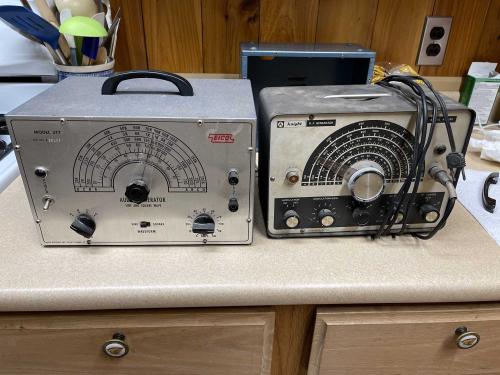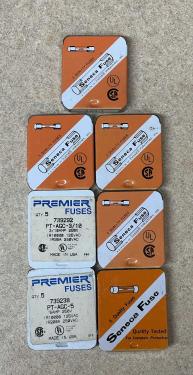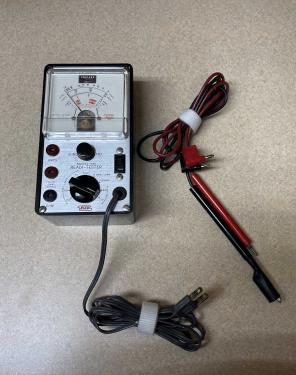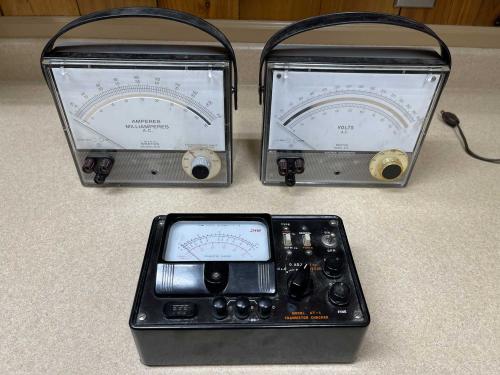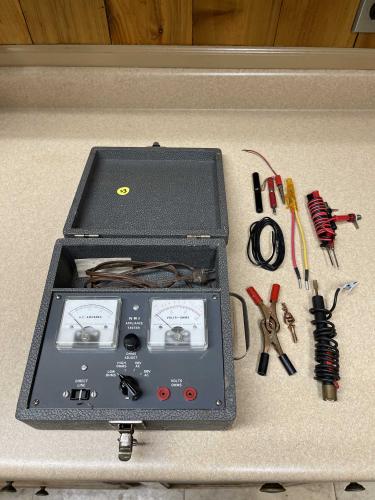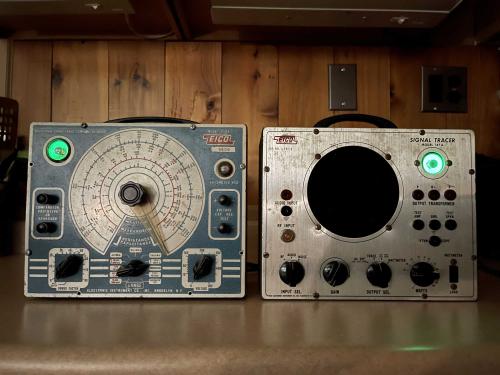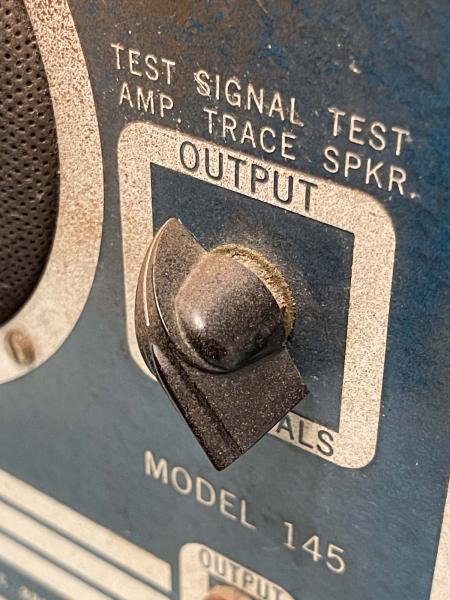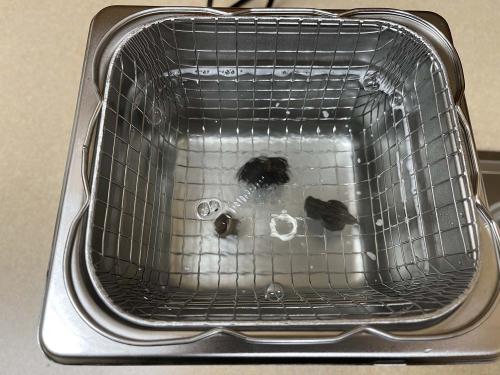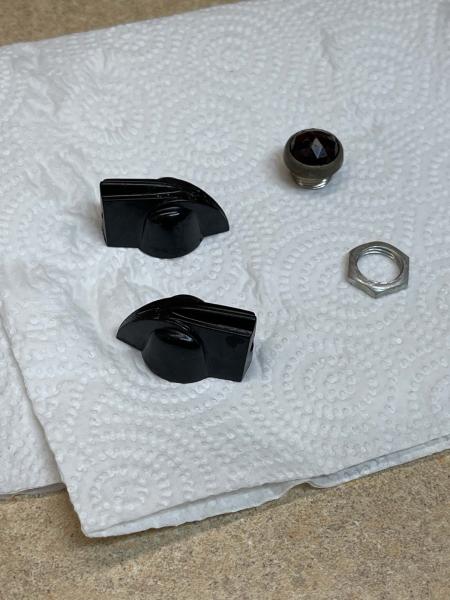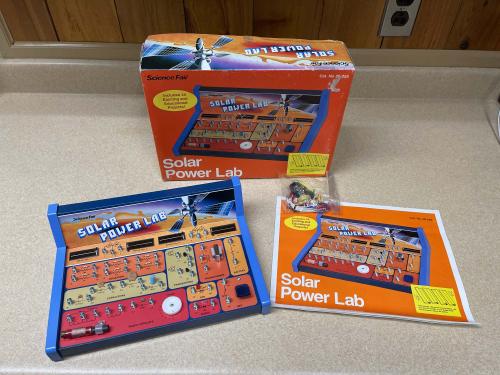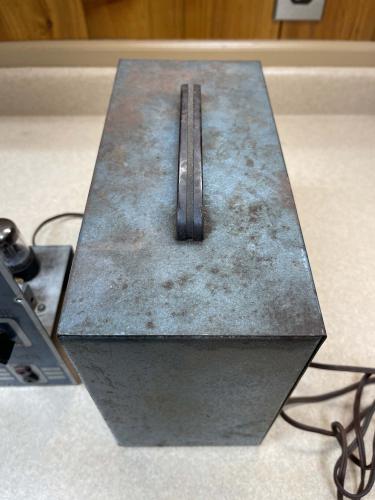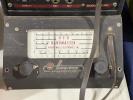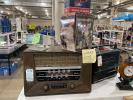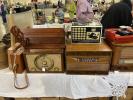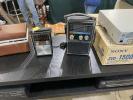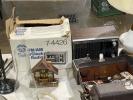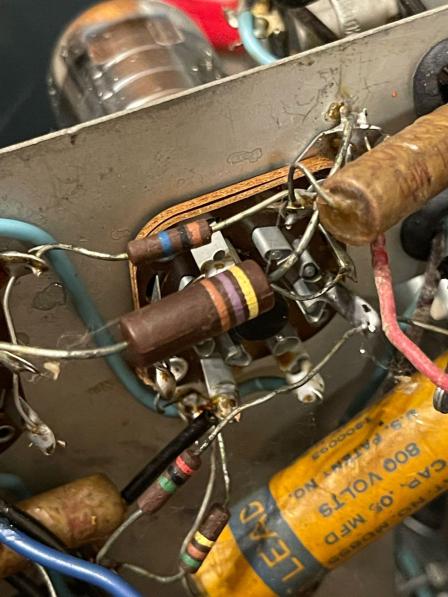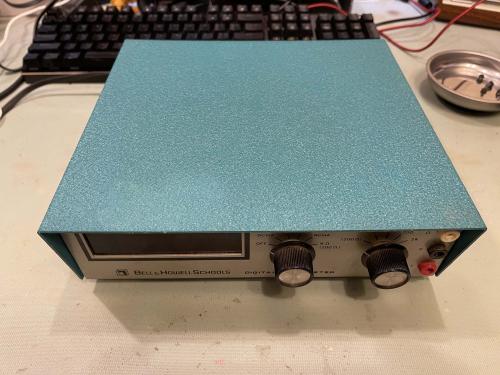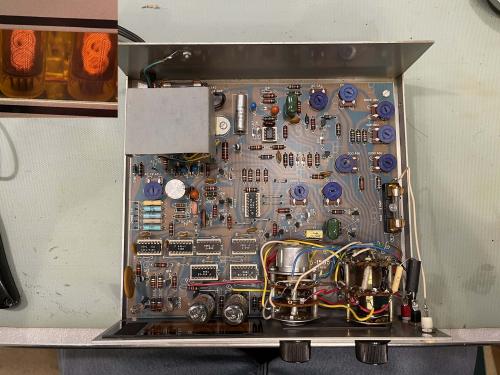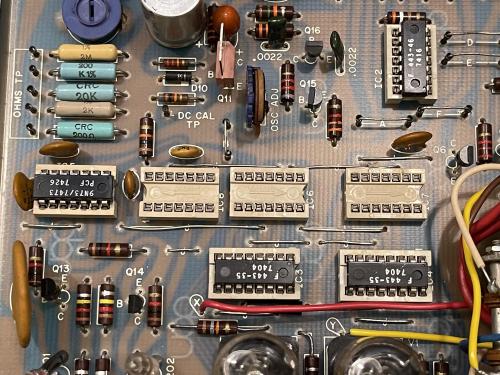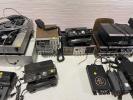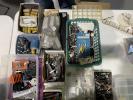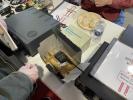- 2024
- Apr
- 29
What I took home from TUSCO 2024
I really didn’t go to this show expecting to buy much, and I didn’t - I spent $30 and brought home these two items:
The audio generator on the left works, but has a messy sinewave output. I’m not sure if this is normal, but knowing some of the other equipment I’ve had from this era - it may be. There are some capacitors in the unit with high ESR, so I may play with it a bit before making further judgement.
The RF generator on the right has an absolutely miserable output, the entire bottom half of the output waveform is clipped off - which I thought was bad. Nope, they apparently overdrove the final amp to the point where that’s the way it worked. It also is overmodulated with internal audio, so this thing was a turd when it was new. I found some suggested fixes, so I may play with it a bit when time allows.
The RF generator was a “Offer I can’t refuse” thing - the guy said take it for $5? Ok, sure!
That’s all - I did want the capacitor checker in my show post, but I restrained myself and someone else picked it up for the low price of $40. Thank you rando for saving me!
- 2024
- Apr
- 25
Stuff I brought home from Cuyahoga Falls 2024.
I did it again. Too much stuff, but I’m going to blame some of the sellers for being so congenial about negotiating on prices! (Yah right!)
So, what did I bring home this year?
Fuses.
This vendor had a lot of different values, including a lot of fractionals that will cost you a small fortune if you buy them new, so I picked up some 1/3, 1/4, 15mA, and 1A varieties. What’s kind of cool about these things is Seneca Fuse used to be a Columbus, OH corporation, and one of the boxes is marked as such. The company was purchased by an entity called Russell Enterprises, which appears to have long since gone out of business.
This is a cool little device that didn’t cost much. It’s a primitive hypot-type device that can test for leakage in a circuit. While primarily designed for appliances and other large current consuming things of yesterday, it still works great as a bench voltage monitor. It also performs it’s other functions without issue, so it was a good find - and it had the manual with it. I’m not sure what the leads were for, this device used EICO’s pin plugs. No worries, another set of leads on the bench is always a good thing!
I actually only wanted the AC Voltmeter in this lot, but the seller was really good on the price for all three, so I came home with the AC Voltmeter, a current meter, and the oddball Sanwa transistor checker. The meters are nice dampened movements and work well, but I haven’t installed batteries in the tester to see if it works. Not sure I will, those little handheld device checkers do an excellent job of sorting parts and identifying things for you.
This little meter in a case was probably part of some course offered by NRI Schools, an early “distance learning” company. (Started in 1914 as National Radio Schools, ended in 1999 as NRI - changing tides on the electronics landscape did them in.) While it’s not really of much use, the real Mueller copper clips and other test leads were well worth the price of $3. The device itself sat in a basement for some time, and it smells like it - if I can get the smell to fade, perhaps I’ll find a use for it.
Here’s the odds ‘n ends portion of the program. An apparently new Ford AM radio that I got for a put-in-the-rack project, a B&K Precision LED voltmeter that matches my capacitor checker, and a surprisingly well written TAB book about early microprocessors. I say “well written” because TAB would publish almost anything. Some books were pretty good, but some were literally nothing more than a guy who wrote a book about taping LEDs to various things and called it “101 electronics projects.”
I don’t need more of these, but they were a good price for functional units, and they’re starting to get outrageously priced. These were checked for operation, and will go into storage as parts donors - or perhaps as resale units once cleaned up and re-capped. Who knows?
In all, it was a good show. I didn’t need to drag home some of that stuff, but I did. I’ll see you at the next show this weekend!
- 2024
- Apr
- 7
An Eico 145 Signal Tracer - Part 2
It’s not really important to operation, but having clean knobs and lenses on indicators is always nice. Since I have an ultrasonic bath, I’m going to use it.
The knobs on this guy are pretty cruddy, and the power indicator has a spritz of bronze paint across it.
While I’m removing the knobs from the volume and function selector, they get a shot of deoxit to clean and lube them.
Everything goes in the bath for 20 minutes.
In the end, they all come out nice and clean and ready to re-install!
Parts have been ordered, we’ll go through those next.
Next part of this series: https://wereboar.com … ignal-tracer-part-3/
Previous part of this series: https://wereboar.com … ignal-tracer-part-1/
- 2024
- Mar
- 28
By the power of the sun!
Remember these things? One of these kits (the 160-in-1 to be exact, which I still have) got me into electronics.
This one is a kit that I always wanted to get, but it never seemed to be available when I had the money. This particular example came from a popular auction site, new in box - even the crappy earphone is there! And yes, I plan on sitting down with it and building a few of the things in it.
It’s kind of a shame that stuff like this isn’t as easily accessible as it once was. Certainly, parts, microcontrollers, and other electronics are far easier to find - but this guided, all the parts are there all the time, no extra stuff save some wire needed kits don’t seem to be around these days. Perhaps the limited use doesn’t appeal to people like it did then?
Regardless, I didn’t necessarily know what the parts were doing, or why, but I knew I wanted to know more.
I salute you, humble kit of parts. You were (and still are) a wonder in a small box.
- 2024
- Mar
- 24
An Eico 145 Signal Tracer - Part 1
( Read the first part of this series here: https://wereboar.com … ignal-tracer-part-0/ )
I’ve decided to give this Eico 145 tracer a new lease on life and put it into service on my test bench - but to do so will require replacing the bad parts. Which ones? Pretty much all of the passives aren’t any good at this point. The device itself isn’t the cleanest example of it’s kind, with lots of battle scars. Paint and rust decorate the front panel and chassis, and input jacks have been added to the front.
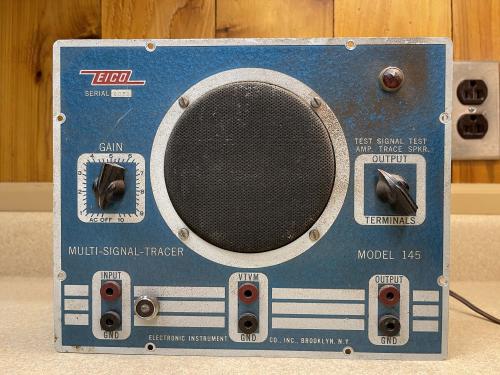
The signs of use are the reasons I’m putting this on the bench. It’s already seen it’s share of use and won’t mind some more.
The chassis has the expected rust and age. That happens, there are no rust outs or severe damage here so I’m not worried about it.
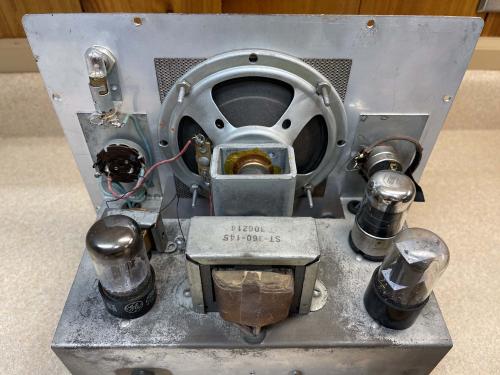
The unit itself has some interesting things about it. There’s supposed to be a 10uF capacitor across this big 470Ω resistor. This is the cathode resistor for the audio output tube, and the capacitor is there to improve audio fidelity. I’m not sure if that was omitted because it’s not going to do much when most of your signal is 1Khz, or if it was damaged and removed at some point. The capacitor visible at the bottom is also an oddity, being an 800V part on the grid of a 6SJ7 - there’s nowhere near 800V present in this unit, and nowhere near B+ on this grid. Why this is such a high voltage part is a mystery but is probably just “That’s what I had on hand.”
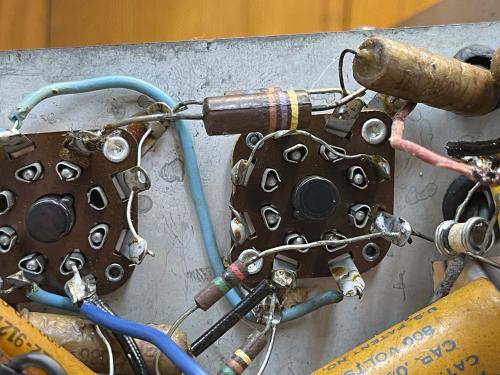
The audio output transformer is somewhat of a mystery as well. I can’t tell if it’s been replaced or was just misdrilled. It doesn’t match the holes in the chassis, so I need to track down the part number and see what it was originally meant for.
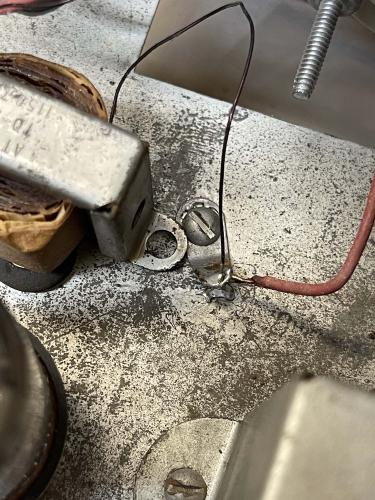
Tape and wire and WTF indicate this thing had multiple repairs over the years. All of that needs to go.
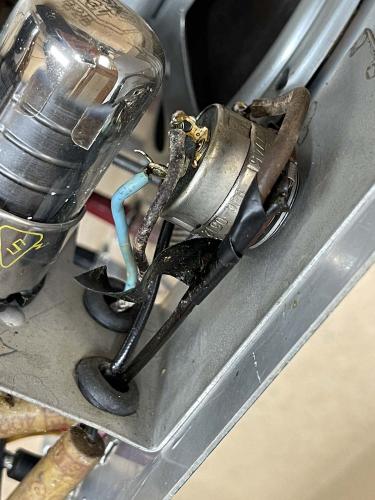
Some more user friendly parts will be added to clean up the device and make it more accessible.
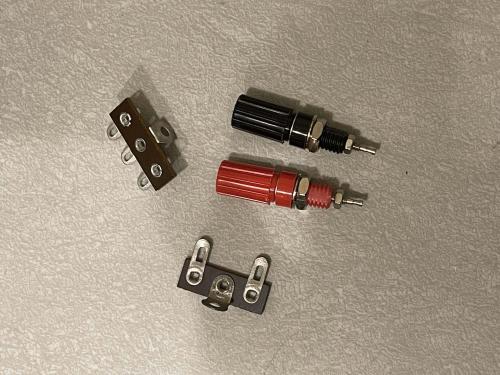
There are some other considerations to take into account. This device was originally meant to be ran on 110VAC - unlike our modern line voltages of 120 to 125VAC. This means B+ is hot, and filament voltage is well over 7VAC - in this case I measured 7.11VAC! That’s too hot, and will burn out the tubes in short order. Another restoration suggested a couple of parallel opposing diodes to drop the voltage in the filament line down, so there will probably be a couple 100V 2A diodes in this thing’s future. It was also suggested that the 6K6 is being run hot, so increasing the cathode resistor’s value (the large 470) would bring the power on the plate of this tube down.
Since most of the parts are being replaced, the analysis is just to make sure there aren’t any major problems that would stop the show - and I don’t see any. The next step is to create a new parts list from the schematic and get things ordered.
I’ll see you in part two with that schematic and a parts list.
Next part of this series: https://wereboar.com … ignal-tracer-part-2/
Previous part of this series: https://wereboar.com … ignal-tracer-part-0/
- 2024
- Mar
- 24
Pictures from the Scott Antique Market
The Scott Antique Market has closed for the season in Columbus, with the next show happening in November. There weren’t enough things to make a post for each of the past few months, so I’ve consolidated everything from this year into this one post.
The normal assortment of radios, televisions, and other electrical oddities showed up, with a number of just interesting or other neat things.
I did pick up one item that will be the subject of it’s own post, but until then - here are all of the things I found interesting from the last three shows.
- 2024
- Mar
- 17
An Eico 145 Signal Tracer - Part 0
I sat down with an Eico 145 Signal tracer this weekend, evaluating what it would need to put it back into daily service. The answer? Pretty much everything. Leaky wax capacitors, carbon comp resistors that are 50% off of their marked value, and a few “doesn’t appear to ever have been installed” parts complete the list of this thing’s issues. It’s amazing that it’s still working, but I would bet that continued operation would destroy the tubes in short order.
The large 470Ω resistor in the foreground was of interest. A quick shout out to a friend confirmed that this was a 2W part, not a high-voltage device. This makes sense, as the resistor could potentially dissipate 600mW at maximum plate current. It’s also interesting because there’s supposed to be a 10uF bypass capacitor across that part, but it looks like it was never installed!
Right under that, of course, is the across the line capacitor. That ’splodey boi gets replaced first.
A quick trip to mouser for components is in my future.
Next part of this series: https://wereboar.com … ignal-tracer-part-1/
Previous part of this series: https://wereboar.com … o-145-signal-tracer/
- 2024
- Mar
- 12
An unusual 115VAC demand meter.
I picked this unusual device up from an antique store in rural Pennsylvania, near where the groundhog works one day a year. It’s a fairly large place and prices vary, but it’s worth a couple hours of your time if you’re into that sort of thing, see the link below.
(The place seems to only have a facebook presence, and I’m not going to post one of those dirty links here - but here is the local chamber’s page for Yoder’s Antique Mall in Punxsutawney: https://punxsutawney … 73c05f142052452104c6.)
It’s a toolbox! Yeah, right on! Well…no, unless you’re interested in old toolboxes. It’s a fairly nice example of something from when Sears used to make things worth more than the metal it was stamped from. It’s what’s inside that I was interested in.
It’s a demand meter! Yeah, right on! Well…yes, but there’s something unusual about this one. It’s a 2-wire, 115VAC unit. While this is similar to what you would have on your house (or would have had before the electronic switchover,) those are usually wired for 230VAC instead.
This one appears to have been meant for sub-branch metering at some point, as evidenced by the easy-to-remove wiring compartment at the bottom of the meter’s housing. Whomever had this before me took advantage of that in that they wired a plug and outlet in line with the device - perhaps as a jobsite meter to pay the site owner for power consumed? Not really sure here save that all of the cable is pretty stiff and in need of replacement if it was going to be used.
Overall age of the device is in question as well - it looks to be 1930s, but Westinghouse probably made these things for decades. I suppose I could try and track it down by serial number, but who knows if those records still exist?
I tried it out by hooking it to a kitchen appliance with a heating element. It works as expected.
I’d like to get it out of it’s silicone covered metal box for a good cleaning, but that’s a project for another day.
- 2024
- Jan
- 21
An IMD-202-2 for parts…but let’s take a quick look anyway!
SO…here’s another one of these piece of crap meters. Why? This one was cheap, and was purchased non-working - primarily for parts, as in the NIXIE tubes. ZM1000 tubes aren’t exactly common these days, so having a few spares laying around seems to be a good idea.
I decided to at least take a look inside to see what’s broken. It doesn’t power up because the fuse is blown. That never bodes well, so I jumpered the fuse temporarily and turned it on quickly.
Yep, it’s got some problems. All segments of the tubes are lit, and the tab on the +5 regulator transistor got pretty warm being on for 5 seconds. Turned it on again to get some quick voltage measurements:
+5V Output (Emitter) = +0.8V
+6V (Base) = +2.6V
Measuring the resistance to ground:
E = 2.8 Ohms.
That’s not good.
A good unit measures (to ground):
E = 1.4MOhms.
+5 primarily powers chips, so I pulled all the ICs to start. Things changed, but not necessarily completely back to normal.
Good unit:
E = 1.4M
B = > 8.5k (charging)
C = Open
Bad unit:
E = 2.5k
B = 1.9k
C = Open
I started putting chips back in, the very first one I replaced (IC5) took the Emitter of the regulator transistor down to 3 Ohms. So that chip is bad.
However, there’s something else wrong. With all the chips gone, the +5 load should be negligible. I did a quick scrape on the transistors to see if one was shorted but didn’t find anything obvious. That leaves old capacitors that could be leaky. This thing is full of Tantalum drops and cheap-ass film caps, any one of those could be partially shorted and there’s no real way to know except to start lifting parts.
Since this is just a parts unit, and the tubes and driver ICs appear good, I think it’s just going in the parts bin as intended. Maybe if I have some snowy Saturday, I’ll pull it out and start lifting parts to see what’s going on. But for now - parts is parts, and parts is what it is.
- 2024
- Jan
- 15
The Sunday Creek ARF Hamfest 2024
I’d never attended this show, but was pleasantly pleased with the turnout. There were perhaps a few dozen vendors and a packed house of visitors in the old gymnasium of the converted school. Quite a bit to look at, and prices were really good. I managed to bring home some good things for a total of $10, almost spending more on drinks and snacks on the way home! I didn’t think the weather was going to cooperate, but it turned out to be just a bit slushy, cold, and windy.
We wandered the aisles for about an hour, taking some time to stop and look at the old photos on the walls from the building’s time as a school, talking to some of the vendors, and digging through boxes of stuff. Since this is so close and easy to get to, I’ll probably attend next year as well - weather permitting of course!
